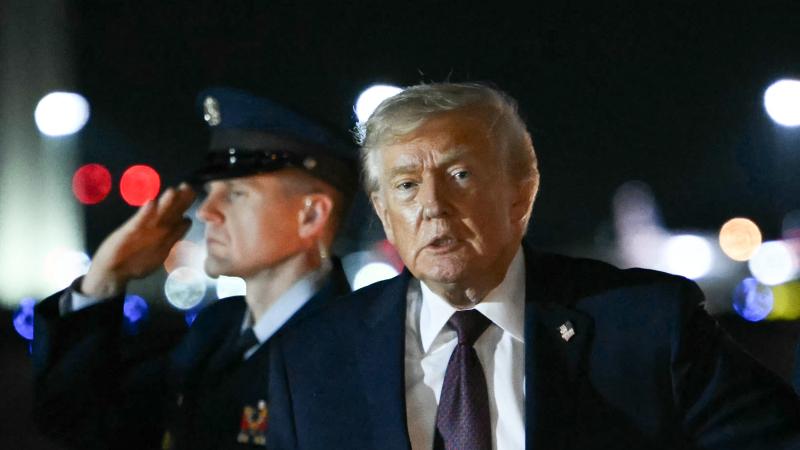Trump in the time of COVID-19: slashing red tape again like he was 39
Easing rules on everything from telemedicine to interstate trucking, the president and his coronavirus team spur creative repurposing and emergency adaptation to fight pandemic
In Washington, leaders typically respond to crises by expanding federal power — drafting new laws and regulations, leaning heavily on federal muscle. The COVID-19 pandemic is revealing President Trump to be a different kind of animal, with instincts and alliances that were forged over years in the private sector, where initiatives tend to move faster and finding creative ways to save money is considered a bragging point. (After all, it is usually one’s own money.)
If the president’s popular approval ratings are reaching new highs, it may be due in part to the Trump the public is seeing on display at the daily briefings of his Coronavirus Task Force. This Trump represents in many ways a return to form for the president, a rebirth of the hard-driving, can-do developer who famously slashed through red tape to restore New York’s iconic Wollman Skating Rink under budget and ahead of schedule 34 years ago.
The president has assembled a Coronavirus Task Force studded with federal agency heads like Dr. Stephen Hahn of the FDA, but their marching orders are clear. As National Institute of Allergy and Infectious Diseases director Dr. Anthony Fauci expressed it in a Task Force briefing back on March 13: “We’re going to be able to remove the constraints so that people at the state and the local level — the individual physician all the way up through the federal government … [are able] to do everything they possibly can.”
Indeed, the medical equipment shortage which has so panicked health care workers from the onset of the crisis often seems to be largely logistical. In other words, a lot of the ventilators and masks are out there — just in unexpected and formerly off-limits places. With a more liberated FDA and Centers for Disease Control (CDC), there’s a whole lotta creative repurposing going on.
Animal hospitals, for instance, are full of ventilators — and they are just like the kind humans use.
"Many people on the human side don't realize we use ventilators on animals,” a vet told ABC News. “They hadn't even thought that that would be a place to look."
But on March 22, the FDA sent out omnibus emergency guidance on ventilators and other respiratory devices, which included permission for ventilators to be "used outside of traditional use." News reports of veterinary hospitals shipping ventilators to human hospitals promptly began to proliferate.
More ventilators (or ventilator-type machinery) may come from the anesthesiology department down the hall from the ICU. It turns out that anesthesia gas machines — the kind that keep patients asleep during surgery — can be converted to supply oxygen to conscious patients. That use has now been approved by the FDA, qualified with a recommendation that they be operated or supervised by anesthesia providers “because of significant differences between the anesthesia gas machine and traditional critical care ventilators.”
In guidance issued on March 2 the FDA opened up supplies of the coveted N95 face mask.
“Why on God’s green earth can I go to Target and buy these items when so many hospitals are running out?” railed one doctor to the New York Times when he found a box of N95s in the construction supply section of an Illinois Walmart.
The reason they were sitting on a shelf at Target is that the FDA formerly made a strict distinction between masks for industry and those for health care (even though they are substantially the same). The consequences of confusing one for the other were underlined by liability regulations that could whack a doctor who used the wrong mask.
All of these distinctions have been waived with the FDA “guidance,” and legislation passed on March 18 helped do away with the liability danger.
Another newly opened area is telemedicine. Formerly, the FDA and Medicare forbade anyone but rural seniors from accessing telemedicine, and they required that the doctor talking to the remote patient be licensed in the same state as the patient. But all of that is now changed, thanks to the temporary easing of rules protecting the privacy of sensitive medical records transmitted over computer networks. Part of that regulatory relaxation has included timely reassurance to doctors that they won’t get sued for patient privacy breeches during the crisis. Now, doctors may even use their own phones to do a computer consult.
Then there is the “Right to Try Act” act, which allows terminally ill patients to try experimental therapies, i.e. those that have completed Phase I testing but have not been approved by the FDA. Greeted with a vast yawn by the press when it was signed into law by the president in May, 2018, its importance has been underlined with the discovery that off-label uses of an anti-malaria drug called hydroxychloroquine may save people dying of COVID-19. President Trump has touted the early promise shown by the drug in treating COVID-19 patients, despite a more cautious posture adopted by Dr. Fauci and press criticism that the president is raising false hopes for a panacea and recklessly inspiring dangerous self-medication and risky experimentation.
Some of the folks hampered from doing more by federal regulations were the nation’s truckers, many of whom were eager to be part of the solution.
"Besides the doctors and nurses and hospitals, we're the next level," a 27-year-old trucker named Daryl Ward told a Memphis television station. “When you’re sleeping, we’re moving.”
The Federal Motor Carrier Safety Administration has now stepped in to issue a nationwide emergency declaration suspending the rule that drivers can only spend 11 hours behind the wheel in a 14-hour workday, provided they are hauling critical supplies like medical equipment, food, hand sanitizer, soap, and disinfectants.
Another federal waiver was needed from the Department of Transportation to reopen truck stops that were initially closed en masse by state governments struggling to comply with the requirement to close nonessential businesses. TV footage of truckers stopped on the sides of interstates, trying to catch naps in their crowded cabs, without a place to eat or use the bathroom, made for good television. So, on March 17, the U.S. Department of Transportation deemed truck stops “essential businesses,” too vital to shut down.
Once upon a time, in the distant ’80s, there was a crippled ice rink sitting on prime Manhattan real estate, at the southeast corner of Central Park. For six humiliating years the city of New York had been attempting to fix it. By 1986, the city had spent $12 million and was about to give it another go, with two or three million more.
Enter a brash 39-year-old real estate developer named Donald J. Trump. He scoffed at what he saw as the city’s ineptitude and bragged that he could restore Wollman Rink to life in four months.
Mayor Edward Koch decided to give him a chance — with $3 million for expenses.
Trump brought the job in one month early with $800,000 left over.
The feat was considered an unmitigated triumph — though a lot of Trump’s advantage had simply come from negotiating respite from normal city contracting and procurement rules.
Even the New York Times found itself wondering: Was it possible “stringent municipal rules on competitive bidding [could] sometimes serve as barriers to getting a job done?”
Was the now 73-year-old Donald Trump remembering his 39-year-old self when he set out to battle a global pandemic?
















